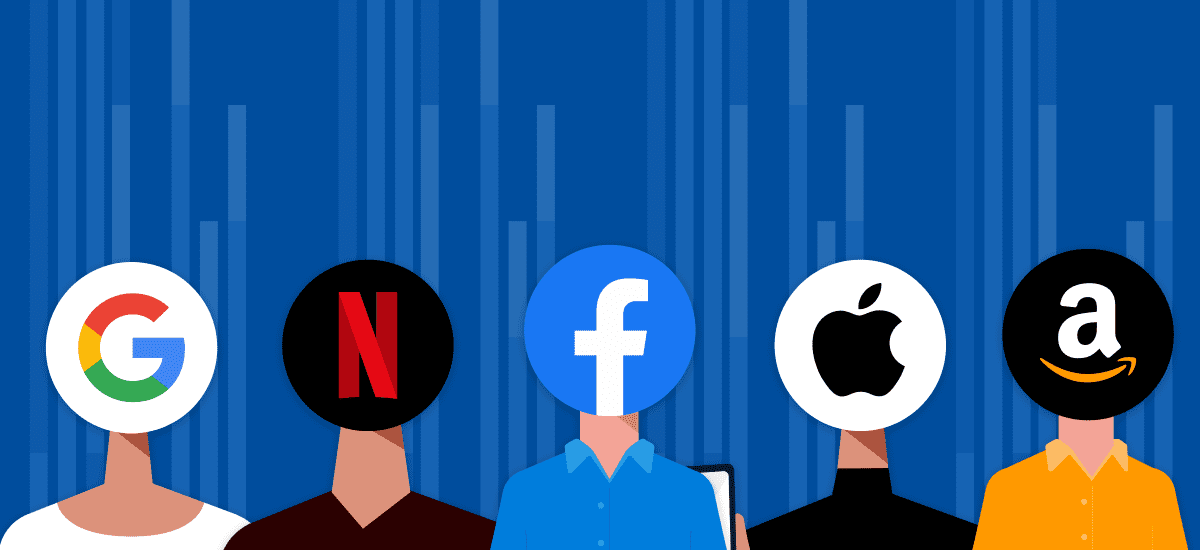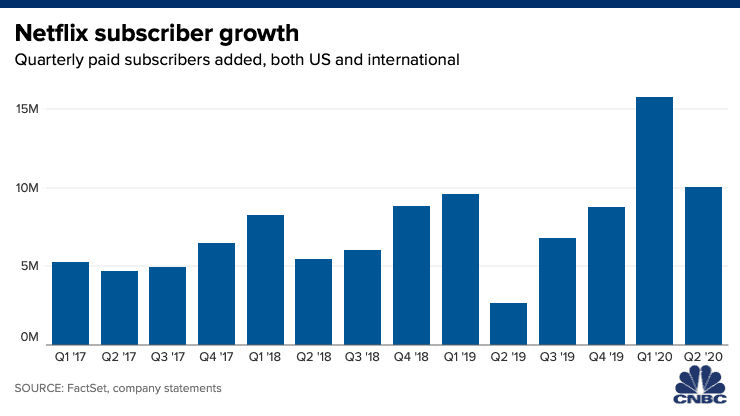With the second-quarter earnings season in its final stretch, some clear winners and losers have emerged. Despite market turmoil in the face of COVID and heightened national interest around antitrust, FAANG stocks continued to outperform broad market and technology stocks in 2020.
According to MarketWatch, “the NYSE FAANG+ Index, an equal-weighted index of 10 liquid large-cap tech stocks, dominated other indexes with a 46% gain year-to-date as of July 24, compared to a 20.7% gain by the Nasdaq 100 Stock Index (NDX) and 18% gain by the S&P North American Technology Sector Index (SPGSTI).” Amidst these massive market gains, last week’s Big Tech Antitrust earnings may indicate a change in the air for America’s corporate giants.
The CEOs of Facebook, Amazon, Apple, and Alphabet appeared before Congress to address worries over Big Tech. Facebook CEO Mark Zuckerberg faced many questions on antitrust, particularly around Facebook’s 2012 purchase of Instagram, with Representative Nadler stating that their purchase was an “anti-competitive acquisition that antitrust laws were intended to prevent.”
To uncover how FANG stocks are communicating this potential shift in tides, we compiled the most relevant themes from FANG stocks earnings calls.
The highlights:
- Facebook sales were stronger than Alphabet. FB spoke about July being flat in Q3, while GOOG saw improvement in July.
- Amazon profitability came in much better than expected.
- All FAANG stocks noted that COVID continues to present an uncertain future, particularly for guidance, but that they are optimistic about Q3 and Q4 results.
Below, you’ll find pull quotes from FAANG earnings call transcripts. Interested in keeping track of FANG stocks? Start your free trial of AlphaSense or login to your account.
Please note highlighting:
Green highlights: positive sentiment
Red highlights: negative sentiment
Read Facebook’s Q2 Earnings Call Transcript
On an uncertain future due to COVID, and Facebook’s return to work: “I expect the rest of this year to continue to be unpredictable. From a health perspective, with COVID growing quickly in the U.S., there’s currently no end in sight for when our teams here will be able to return to our offices.”
On revenue growth throughout Q2: “After seeing flat year-over-year revenue growth in the first few weeks of April, we saw a considerable recovery in May and June. Our total ad revenue for Q2 was $18.3 billion, which is a 10% year-over-year increase.”
On strong financials, DAUs and MAUs: “Facebook itself continued to grow with daily active users reaching 1.79 billion, up 12% compared to last year. DAUs represented approximately 66% of the 2.7 billion monthly active users in June. MAUs grew by 287 million or 12% compared to last year. Turning now to the financials. Q2 total revenue was $18.7 billion, up 11% or 12% on a constant currency basis. Had foreign exchange rates remained constant with Q2 of last year, total revenue would have been $297 million higher. Q2 ad revenue was $18.3 billion, up 10% or 12% on a constant currency basis. As Sheryl mentioned, ad revenue growth in the quarter was stronger in May and June relative to April. In terms of verticals, we saw particular strength from both new and existing online commerce and service advertisers who primarily leverage our direct response ad formats.”
On ad revenue growth and decline: “On a user regional basis, ad revenue growth was strongest in U.S. and Canada, Asia Pacific and Europe, which grew 14%, 11% and 9%, respectively. Rest of world declined 6% and was impacted by challenging macroeconomic conditions as well as foreign currency headwinds.”
On July performance: “In the first 3 weeks of July, our year-over-year ad revenue growth rate was approximately in line with our Q2 ad revenue growth rate of 10%. We expect our full quarter Q3 year-over-year ad revenue growth rate to be roughly similar to this July performance.”
Apple
Read Apple’s Q2 Earnings Call Transcript
On Q2 results: “Total revenue was $59.7 billion, a new June quarter record, up 11% from a year ago despite a 300 basis point headwind from foreign exchange. Our performance was strong across our entire portfolio as we grew revenue in each of our product categories and set June quarter records for Mac, for wearables and for services. Similarly, our results were very strong all around the world, with growth in all geographic segments and new June quarter records in the Americas, in Europe, in Japan and rest of Asia Pacific.Products revenue was $46.5 billion, up 10% and a June quarter record. iPhone returned to growth and we saw very strong double-digit growth from iPad, Mac and wearables.”
- On Mac performance: “Revenue was $7.1 billion, up 22% over last year and a June quarter record.”
- On wearables, home, and accessories: “Wearables, Home and Accessories established a new June quarter record with revenue of $6.5 billion, up 17% year-over-year
- On iPad performance: ”Pad performance was equally impressive with revenue of $6.6 billion, up 31% and our highest June quarter revenue in 8 years.”
On uncertainty due to COVID and planning for Q3: “Similar to last quarter, given the uncertainty around the world in the near term, we will not be issuing revenue and margin guidance for the coming quarter…”
Amazon
Read Amazon’s Q2 Earnings Call Transcript
On uncertainty due to COVID, and potential impacts to the business: “This guidance also reflects our estimates to date regarding the impact of the COVID-19 pandemic on our operations, including those discussed in our filings with the SEC, and is highly dependent on numerous factors that we may not be able to predict or control, including: the duration and scope of the pandemic, including any recurrence; actions taken by governments, businesses and individuals in response to the pandemic; the impact of the pandemic on global and regional economies and economic activity, workforce staffing and productivity and our significant and continuing spending on employee safety measures; our ability to continue operations in affected areas; and consumer demand and spending patterns as well as the effects on suppliers, creditors and third-party sellers, all of which are uncertain.”
On strong demand for groceries and consumable products: “As I mentioned on our last earnings call, we began to see a significant increase in customer demand beginning in early March, and demand remained elevated throughout Q2. Strong early demand in groceries and consumable products continued into Q2, while demand increased during the quarter in our other major product categories like hardlines and softlines.”
On AWS growth: “Turning to AWS. This is now a $43 billion annualized run rate business, up nearly $10 billion in run rate in the last 12 months. Customer usage remains strong, although growth varies across industries as a result of the COVID-19 crisis.”
On Prime Day shifting: “Lastly, we plan to host Prime Day in Q4 this year rather than Q3 as it has been in prior years. The one exception is Amazon India, which will host Prime Day on August 6 and August 7.”
Netflix
Read Netflix’s Q2 Earnings Call Transcript
On Q2 performance and Q3 guidance: “When we think about the guidance for Q3, we’re not thinking about Q3 just in and of itself. We have to look at it in the context of what just happened in Q2. And we just added 10 million members, which is the largest growth we’ve ever had in a second quarter. And if you look at the — so we kind of look at the totality across the Q2 and Q3 period. And if we look at that quarterly period, 2 quarters in a row, the best we’ve ever done in that period is actually 2 years ago in 2018, where we grew by 11.5 million numbers. So if we, this year, deliver on that Q3 guidance, that means we’re growing 12.5 million members in that same time period, which is 1 million more than we’ve ever done, which is we think big growth on top of what was already a very big Q1.”
On new content models: “Last year, we had barely dabbled in competition and reality programming. This quarter alone, with Floor is Lava and Too Hot to Handle, we had 2 of our biggest hits ever in that — not just in that genre but in our — all of our programming.”
On user retention amid COVID: “Actually, the retention across every cohort is as good or better than pre-COVID”
On cash flow: “When you think about cash flow going forward, it was sort of a bit of a unique window into that forward-looking cash generation opportunity or potential for our business because of the pandemic. So we generally are forward-investing into the growth of our business and into content. So our content cash spend is in excess of our content expense in a given year. But because of the pause in productions, you can see that basically, that cash spend and expense in content were the same this quarter, essentially at a 1:1 ratio. And as a result — as we said in the letter, resulted in a 15% cash flow — free cash flow margin. Going forward, we do expect to turn cash flow negative again in 2021 and as our business and our production ramps up, but we’re still on that multiyear path to being cash flow positive. And when we are sustaining cash flow positive, we expect to be a much bigger and more profitable business. So hopefully, that 15% cash flow margin is just the start.”
Alphabet
Read Alphabet’s Q2 Earnings Call Transcript
On COVID’s impact: “The macroeconomic environment caused by the pandemic created headwinds for our business. Our revenue declined on a reported basis and is flat year-over-year on a fixed FX basis. Like other companies, this quarter, we saw the early signs of stabilization as users return to commercial activity online. This is true across most of our advertising verticals and geographies. Of course, the economic climate remains fragile.”
On CapEx and buybacks: “Turning now to CapEx and operating cash flow. Cash CapEx for the quarter was $5.4 billion, which I will discuss in the Google segment results. Operating cash flow was $14 billion with free cash flow of $8.6 billion. We repurchased $6.9 billion of our shares. We ended the quarter with cash and marketable securities of approximately $121 billion.”
On search trends and ad revenue: “I would say that following a rough end to the first quarter, ads revenue gradually improved in the quarter, not only in Search, but YouTube and Network. And so for Search, we ended March at a midteens percentage decline in year-on-year revenues. And then as we progressed through the second quarter, we saw a gradual return in user search activity to more commercial topics, and then that was followed by an increase in spending by advertisers. So that resulted in a gradual improvement in year-on-year Search revenue trends in the second quarter. We ended basically flat to last year by the end of June and you know to carry it forward, although we’re pleased that ads revenue gradually improved throughout the quarter.”




